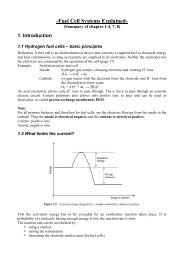Chapter 8. ORGANIC SOLAR CELLS - from and for SET students
Chapter 8. ORGANIC SOLAR CELLS - from and for SET students
Chapter 8. ORGANIC SOLAR CELLS - from and for SET students
Create successful ePaper yourself
Turn your PDF publications into a flip-book with our unique Google optimized e-Paper software.
<strong>SOLAR</strong> <strong>CELLS</strong> <strong>Chapter</strong> <strong>8.</strong> Exciton solar cells<br />
as a consequence the thickness of the photovoltaic device can be extended to the µm range,<br />
resulting in optically dense cells. From a technology point of view, however, the liquid<br />
electrolyte represents a drawback. Hence, much research has focused on replacing the liquid<br />
electrolyte by a solid hole transporting material. The most promising replacement is a solid,<br />
wide-b<strong>and</strong> gap hole transporting material resulting in power conversion efficiencies of 3%.<br />
Another new concept <strong>for</strong> a solid-state Grätzel cell consists of a polymer or organic<br />
semiconductor that combines the functions of light-absorption <strong>and</strong> charge (hole) transport in a<br />
single material <strong>and</strong>, there<strong>for</strong>e, is able to replace both the dye <strong>and</strong> the hole transporting<br />
material. The photoinduced charge separation at the interface of an organic <strong>and</strong> inorganic<br />
semiconductor has been studied in relation to photovoltaic devices. When an organic or<br />
polymeric semiconductor is excited across the optical b<strong>and</strong> gap, the excitation energies <strong>and</strong><br />
valence b<strong>and</strong> offsets of this molecular semiconductor may allow electron transfer to the<br />
conduction b<strong>and</strong> of an inorganic semiconductor, similar to the ruthenium dye. The dimensions<br />
of the nanopores in TiO2 are even more important here, because excitations are no longer<br />
created at the interface only, but throughout the whole organic material. Because essentially<br />
all excitons must be able to reach the interface with the TiO2 <strong>for</strong> efficient charge separation<br />
<strong>and</strong> energy conversion, the distance between the site of excitation <strong>and</strong> the interface must be<br />
within the exciton diffusion length. As discussed previously, in most organic materials, the<br />
exciton diffusion length is limited to 5-10 nm by the fast intrinsic decay processes of the<br />
photoexcited molecules. Creating nanoporous TiO2 of such dimensions, <strong>and</strong> filling it<br />
completely with an organic semiconductor, is currently one of the challenges in this area.<br />
-<strong>8.</strong>12-






